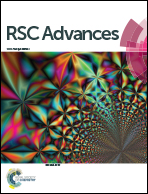Todorokite-type manganese oxide nanowires as an intercalation cathode for Li-ion and Na-ion batteries
Abstract
Extended hydrothermal treatment at an elevated temperature of 220 °C allowed high yield synthesis of manganese oxide nanowires with a todorokite crystal structure suitable for ions intercalation. The flexible, high aspect ratio nanowires are 50–100 nm in diameter and up to several microns long, with 3 × 3 structural tunnels running parallel to the nanowire longitudinal axis. The tunnels are occupied by magnesium ions and water molecules, with the chemical composition found to be Mg0.2MnO2·0.5H2O. The todorokite nanowires were, for the first time, electrochemically tested in both Li-ion and Na-ion cells. A first discharge capacity of 158 mA h g−1 was achieved in a Na-ion system, which was found to be greater than the first discharge capacity in a Li-ion system (133 mA h g−1). Despite large structural tunnel dimensions, todorokite showed a significant first cycle capacity loss in a Na-ion battery. After 20 cycles, the capacity was found to stabilize around 50 mA h g−1 and remained at this level for 100 cycles. In a Li-ion system, todorokite nanowires showed significantly better capacity retention with 78% of its initial capacity remaining after 100 cycles. Rate capability tests also showed superior performance of todorokite nanowires in Li-ion cells compared to Na-ion cells at higher current rates. These results highlight the difference in electrochemical cycling behavior of Li-ion and Na-ion batteries for a host material with spacious 3 × 3 tunnels tailored for large Na+ ion intercalation.


 Please wait while we load your content...
Please wait while we load your content...